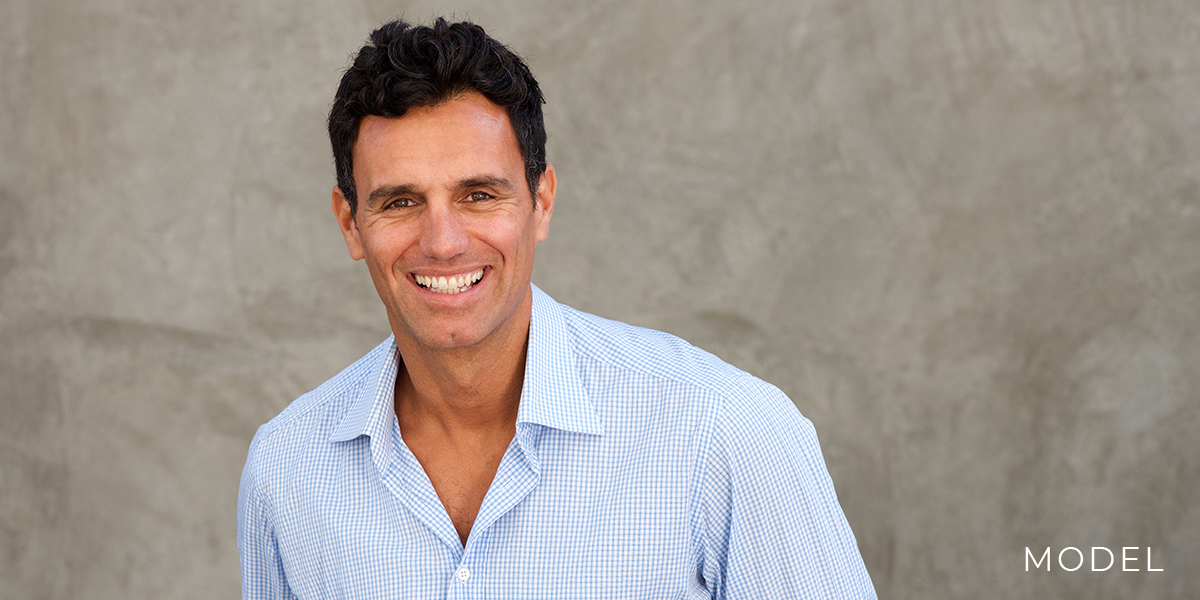Even if you have worn dentures for decades, there is still time to get dental implants. The doctors at Burbank Periodontics can replace each missing tooth with a dental implant or use four to six implants to support a denture for improved function and a natural-looking smile. What is involved with switching from removable dentures to implants?
Getting Dental Implants After Wearing Dentures
Getting dental implants when you wear dentures begins with a consultation. One of our doctors will listen to your concerns and goals before performing a comprehensive exam and taking a 3-D cone beam CT scan to determine if you are a candidate for dental implants. Our doctor will explain your options and whether you need additional procedures to prepare for dental implants.
Why Consider Getting Implants If You Have Dentures?
If you wear dentures, your jawbone will shrink without dental implants to stimulate bone growth. Eventually, your jawbone ridge will become too narrow to keep a denture in place. Narrowing jawbone creates these concerns:
- Dentures that lift or move when you speak or eat
- Gum and bone irritation
- Accelerated bone shrinkage from the pressure of a denture on your bone
- Premature facial sagging when most or all your teeth are missing
Even if you get a new denture, it will continue to fit poorly as your jawbone progressively shrinks.
What Are the Benefits of Getting Implants If You Have Dentures?
If you have dentures, the benefits of getting dental implants include the following:
- Bone preservation – Jawbone stimulation from dental implants prevents bone shrinkage and facial sagging.
- Comfort – Your denture will feel more like natural teeth.
- Function – It is easier to speak and eat with implant-supported dentures.
- Aesthetics – Your smile will look natural.
Replacing a Partial Denture with Dental Implants
A dental implant can replace each missing tooth if you wear a partial denture by acting as an artificial tooth root. After one of our doctors places your dental implants in your jawbone, you can expect the following:
- Allow three to four months while the implants and your jawbone integrate.
- Return to Burbank Periodontics to get the implants exposed so your gums can form around them.
- Return to your general dentist to take impressions of your mouth to ensure your final implant crowns fit precisely.
Replacing a Complete Denture with Dental Implants
If you wear a removable complete denture, you can get an implant-supported denture. After dental implant placement, you will wear temporary replacement teeth. Then, you can expect the following:
- Three to four months of healing while your jawbone fuses to the dental implants
- Returning to our office to expose the implants
- Returning to your dentist to take impressions of your mouth for custom dentures
How Does an Implant-Supported Denture Work?
Your dentist will ensure the base of your denture has attachments for snapping, clipping, or screwing the denture onto dental implants. Your dentist will check your denture fit and bite and secure it to dental implants.
How Many Implants Will You Need for an Overdenture?
The number of implants required for an overdenture depends on several factors, including:
- Your oral health
- Jawbone volume
- The level of stability you want for your implant overdenture
Denture stability increases with the number of implants placed.
Implant Overdenture Types
Implant overdenture types include the following:
- Snap-on denture – Two to four dental implants can support a denture that you can snap on and off. Nightly removal helps you keep your denture clean and lets your gums rest.
- All-on-4® dental implants – Periodontists use the All-on-4® treatment concept for patients with low bone volume to minimize the need for bone grafting. All-on-4® implants are fixed, or non-removable implant dentures that screw on, and only a trained professional can remove the denture.
- Standard implants – You can get four or more dental implants to stabilize your denture. If you have worn a denture for years, your jawbone may need augmentation to support dental implants.
How Does Jawbone Shrinkage Affect Dental Implants?
According to the Academy of Osseointegration, vertical and horizontal bone shrinkage occurs with missing teeth, but you need enough bone volume to support dental implants. A cone beam CT scan will help assess your bone volume and determine if you need a bone graft procedure.
Will You Need a Bone Graft for Dental Implants?
If a cone beam CT scan reveals that you lack enough bone volume for dental implants, you will need a bone graft to rebuild the bone. What to expect with bone grafting:
- After one of our doctors performs a grafting procedure, your body will grow more tissue to support dental implants for your replacement teeth.
- Depending on the type of bone graft, the procedure, and the extent of bone loss, the Academy of Osseointegration says it can take four to twelve months for grafts to heal. After healing, you can receive dental implants.
- Afterward, you will be ready for an implant crown to replace a partial denture or an implant-supported denture to replace your removable complete denture.
Transition to Dental Implants With Burbank Periodontics
If you wear a partial or complete denture, it is still possible to transition to dental implants. At Burbank Periodontics, you will meet with one of our highly credentialed specialists who will evaluate your oral health and explain whether you can benefit from dental implants.










